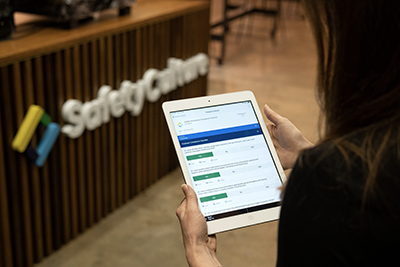 It takes a long-term commitment to consistent, incremental changes in daily operations for manufacturers to maximize the benefits of continuous improvement programs like Lean and Kaizen. And continuous improvement will only be achieved through the engagement of everybody, from the front line to upper management.
It takes a long-term commitment to consistent, incremental changes in daily operations for manufacturers to maximize the benefits of continuous improvement programs like Lean and Kaizen. And continuous improvement will only be achieved through the engagement of everybody, from the front line to upper management.
This is where technology comes in. Since continuous improvement programs are really a series of step-by-step process changes, the journey of effective implementation can only progress with technology that is, by nature, easy to adopt.
In a growing tech marketplace, there is often a gap between investment decision and actual adoption of new technology. When a decision is made at an executive level it can fail to translate to the frontline – with workers too often reporting difficulties with using tech systems and working around the technology instead. This is a common blindspot for companies and results in both a major wasted investment for the company and a lost opportunity to improve operations and safety.
When looking at implementing new technology systems – and the many potential benefits it brings – it’s important to start with the end user top of mind. Taking this approach means that the frontline is central to the process and avoids a ‘white elephant’ investment.
In order to make sure your company is making the right business dissection, look for intuitive tech, the ability to create streamlined processes and proactive reporting.
Lead with intuitive tech
 Manufacturing companies are constantly looking at ways to improve efficacy, safety, and productivity. Technology cannot deliver on one point while failing the others, it needs to succeed on all three measures.
Manufacturing companies are constantly looking at ways to improve efficacy, safety, and productivity. Technology cannot deliver on one point while failing the others, it needs to succeed on all three measures.
Enter intuitive technology. This software is designed from the outset with the user at its core. Starting with the user and working backwards towards the product ensures that it is made with functionality in mind and solves problems for frontline workers. These are teams that have to be able to conduct inspections from anywhere, with or without wifi, to control documentation and usage, and facilitate swift and seamless changovers.
SafetyCulture’s flagship product iAuditor was born out of a need for a simple solution to this problem — one that would allow people to pick up their phones and be able to use our tech immediately, without much training or a huge implementation rollout. It allows teams to conduct inspections from anywhere, control documents and use, and collects data that shows wider trends in safety and productivity. It was also created as a mobile-first platform, so in busy environments like manufacturing, workers can use the application without needing a folder of paper or going back and forth to a computer.
Another hallmark of intuitive technology is its flexibility — digital tools are constantly evolving, taking into account customer feedback, user research and new situations. It’s a lengthy feedback loop but its depth allows teams to stay in touch with their customers and the environment they operate in. Creating technology in this way has revolutionised safety reporting and enables companies to be on the front foot.
Streamline processes
In the past organisations have been reactive to issues and relied on a top-down approach to management. This has resulted in slow moving processes and procedures written by people who lack frontline experience and expertise.
Recently, this approach has started to change. Businesses have recognised that in order to create processes that work, frontline workers need to be consulted with and listened to. Removing the bureaucracy to engage directly with a workforce, provides front-line employees with ownership and responsibility for driving change.
For an organisation to thrive, workers need to be given the right tools. When it comes to improving workplace safety and efficacy, it’s essential that frontline workers drive momentum rather than be slowed down with ineffective tools.
Proactive reporting
Once the right technology is in place, organisations can look at ways to improve safety measures including incident and accident reporting. With technology, companies can create a culture that values safety and risk mitigation. Workers can record not just incidents but also ‘near misses’, which identifies issues – before they actually happen. Near miss data can then inform how to control the issue and provide valuable follow-up actions to ensure workers are learning from the report.
Risk is inherent to the sector, but with the right tools it can be improved. Rather than be caught up in management, give frontline workers the tools they need to succeed. Only then can organisations implement a continuous improvement program that adjusts over time and develop its own feedback loop – collecting data that gives both a macro and micro view of operations and where improvements lie.
Discover how manufacturing companies like yours are using iAuditor by SafetyCulture to drive operational excellence. Download this report and revamp your operations strategy with emerging industry trends.
About SafetyCulture:
SafetyCulture is the operational heartbeat of working teams around the world. Its mobile-first operations platform leverages the power of human observation to identify issues and opportunities for businesses to improve everyday. More than 28,000 organisations use its flagship products, iAuditor and EdApp, to perform checks, train staff, report issues, automate tasks and communicate fluidly. SafetyCulture powers over 600 million checks per year, approximately 50,000 lessons per day and millions of corrective actions, giving leaders visibility and workers a voice in driving safety, quality and efficiency improvements.


